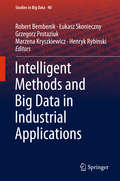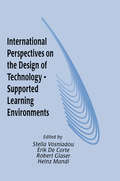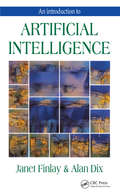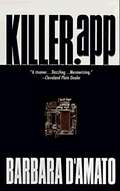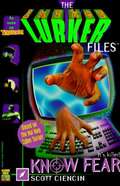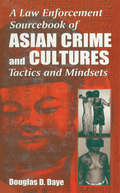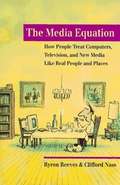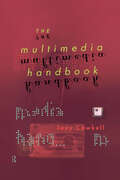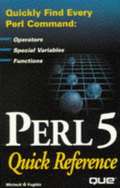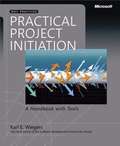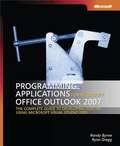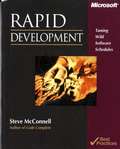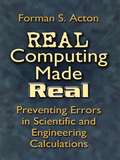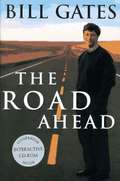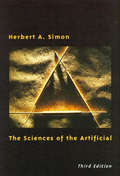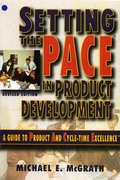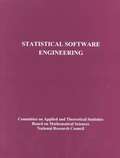- Table View
- List View
Intelligent Methods and Big Data in Industrial Applications (Studies in Big Data #40)
by Henryk Rybinski Marzena Kryszkiewicz Grzegorz Protaziuk Łukasz Skonieczny Robert BembenikThe inspiration for this book came from the Industrial Session of the ISMIS 2017 Conference in Warsaw. It covers numerous applications of intelligent technologies in various branches of the industry. Intelligent computational methods and big data foster innovation and enable the industry to overcome technological limitations and explore the new frontiers. Therefore it is necessary for scientists and practitioners to cooperate and inspire each other, and use the latest research findings to create new designs and products. As such, the contributions cover solutions to the problems experienced by practitioners in the areas of artificial intelligence, complex systems, data mining, medical applications and bioinformatics, as well as multimedia- and text processing. Further, the book shows new directions for cooperation between science and industry and facilitates efficient transfer of knowledge in the area of intelligent information systems.
International Perspectives on the Design of Technology-supported Learning Environments
by Robert Glaser Stella Vosniadou Erik De Corte Heinz MandlIn recent years, the use of technology for the purposes of improving and enriching traditional instructional practices has received a great deal of attention. However, few works have explicitly examined cognitive, psychological, and educational principles on which technology-supported learning environments are based. This volume attempts to cover the need for a thorough theoretical analysis and discussion of the principles of system design that underlie the construction of technology-enhanced learning environments. It presents examples of technology-supported learning environments that cover a broad range of content domains, from the physical sciences and mathematics to the teaching of language and literacy. The emphasis in this book is not on the design of educational software but on the design of learning environments. A great deal of research on learning and instruction has recently moved out of the laboratory into the design of applications in instructional settings. By designing technology-supported learning environments instructional scientists attempt to better understand the theories and principles that are explicit in their theories of learning. The contributors to this volume examine how factors such as social interaction, the creation of meaningful activities, the use of multiple perspectives, and the construction of concrete representations influence the acquisition of new information and transfer.
An Introduction To Artificial Intelligence
by Janet FinlayAn authoritative and accessible one-stop resource, An Introduction to Artificial Intelligence presents the first full examination of AI. Designed to provide an understanding of the foundations of artificial intelligence, it examines the central computational techniques employed by AI, including knowledge representation, search, reasoning, and learning, as well as the principal application domains of expert systems, natural language, vision, robotics, software agents and cognitive modeling. Many of the major philosophical and ethical issues of AI are also introduced.Throughout the volume, the authors provide detailed, well-illustrated treatments of each topic with abundant examples and exercises. The authors bring this exciting field to life by presenting a substantial and robust introduction to artificial intelligence in a clear and concise coursebook form. This book stands as a core text for all computer scientists approaching AI for the first time.
An Introduction to Distributed Algorithms
by Valmir C. BarbosaAn Introduction to Distributed Algorithms takes up some of the main concepts and algorithms, ranging from basic to advanced techniques and applications, that underlie the programming of distributed-memory systems such as computer networks, networks of workstations, and multiprocessors. Written from the broad perspective of distributed-memory systems in general it includes topics such as algorithms for maximum flow, program debugging, and simulation that do not appear in more orthodox texts on distributed algorithms. Moving from fundamentals to advances and applications, ten chapters--with exercises and bibliographic notes--cover a variety of topics. These include models of distributed computation, information propagation, leader election, distributed snapshots, network synchronization, self- stability, termination detection, deadlock detection, graph algorithms, mutual exclusion, program debugging, and simulation. All of the algorithms are presented in a clear, template- based format for the description of message-passing computations among the nodes of a connected graph. Such a generic setting allows the treatment of problems originating from many different application areas. The main ideas and algorithms are described in a way that balances intuition and formal rigor--most are preceded by a general intuitive discussion and followed by formal statements as to correctness complexity or other properties.
KILLER.app
by Barbara D'AmatoTo Chicago cop Suze Figueroa, cyberspy is not in her job description--until a mysterious accident sends her computer engineer sister into a coma. Did the "accident" have anything to do with the secret database her sister discovered at the mega-corporation where she worked? SJR Computer Systems doesn't want the Figueroa sisters or anyone else alive to ask that question. Targeted by a network of on-line henchmen and ruthless flesh-and-blood assassins, Suze uncovers a plan far more sophisticated and insidious than she could have imagined, and finds herself in a race to stop a computer genius from taking control of the information age. Barbara D'amato's books not only present complex investigations and gripping suspense, each abounds in information about a specific topic as diverse as The Wizard of Oz and Christmas tree farming. All of the 9 books in the Cat Marsala series are in the Bookshare collection as well as four others.
Know Fear (The Lurker Files #2)
by Scott CiencinThe Lurker continues to reign at Wintervale University -- a dark, terrible force at the heart of the campus computer network, weaving an electronic web of deceit. The Lurker can never have too many minions...
A Law Enforcement Sourcebook of Asian Crime and CulturesTactics and Mindsets
by Douglas D. DayeEven in multicultural North America, few whites, blacks, or Hispanics have extensive experience or understanding of Asian culture. For experienced police officers, intelligence analysts, correctional officers, and prosecutors, the problems of cultural differences in behavior remain complex and problematic. This book addresses these specific law enforcement problems, and supplies law enforcement professionals with information and strategies for easier arrests, more accurate intelligence, more successful prosecutions, and fewer problems during incarceration.
Learning GNU Emacs, 2nd Edition
by Debra Cameron Eric S. Raymond Bill RosenblattThis comprehensive guide to the GNU Emacs editor, one of the most widely used and powerful editors available under UNIX, covers basic editing, several important "editing modes" (special Emacs features for editing specific types of documents, including email, Usenet News, and the Web), and customization and Emacs LISP programming. It is aimed at new Emacs users, whether or not they are programmers. Covers Version 19.30.
The Media Equation: How People Treat Computers, Televisions, and New Media Like Real People and Places
by Byron Reeves Clifford NassAccording to popular wisdom, humans never relate to a computer or a television program in the same way they relate to another human being. Or do they? The psychological and sociological complexities of the relationship could be greater than you think. In an extraordinary revision of received wisdom, Byron Reeves and Clifford Nass demonstrate convincingly in The Media Equation that interactions with computers, television, and new communication technologies are identical to real social relationships and to the navigation of real physical spaces. Using everyday language, the authors explain their novel ideas in a way that will engage general readers with an interest in cutting-edge research at the intersection of psychology, communication and computer technology. The result is an accessible summary of exciting ideas for modern times. As Bill Gates says, '(they) ... have shown us some amazing things'.
ML for the Working Programmer
by Lawrence C. PaulsonThe new edition of this successful and established textbook retains its two original intentions of explaining how to program in the ML language, and teaching the fundamentals of functional programming. The major change is the early and prominent coverage of modules, which the author extensively uses throughout. In addition, Paulson has totally rewritten the first chapter to make the book more accessible to students who have no experience of programming languages. The author describes the main features of new Standard Library for the revised version of ML, and gives many new examples, e.g. polynomial arithmetic and new ways of treating priority queues. Finally he has completely updated the references. Dr. Paulson has extensive practical experience of ML, and has stressed its use as a tool for software engineering; the book contains many useful pieces of code, which are freely available (via Internet) from the author. He shows how to use lists, trees, higher-order functions and infinite data structures. He includes many illustrative and practical examples, covering sorting, matrix operations, and polynomial arithmetic. He describes efficient functional implementations of arrays, queues, and priority queues. Larger examples include a general top-down parser, a lambda-calculus reducer and a theorem prover. A chapter is devoted to formal reasoning about functional programs. The combination of careful explanation and practical advice will ensure that this textbook continues to be the preferred text for many courses on ML for students at all levels.
The Multimedia Handbook
by Tony CawkellThe Multimedia Handbook provides a comprehensive guide to the wide range of uses of multimedia. The first part of the book introduces the technology for the non-specialist. Part Two covers multimedia applications and markets. Tony Cawkell details the huge array of authoring software which is now available, as well as the distribution of multimedia data by telephone, cable, satellite or radio communications. There is an extensive bibliography, a glossary of technical terms and acronyms and a full index.
Perl 5 Quick Reference
by Michael FoghluA really handy quick reference manual for the perl web scripting language.
Practical Project Initiation
by Karl E WiegersZero in on key project-initiation tasks--and build a solid foundation for successful software development. In this concise guide, critically-acclaimed author Karl E. Wiegers fills a void in project management literature by focusing on the activities that are essential--but often overlooked--for launching any project. Drawing on his extensive experience, Karl shares lessons learned, proven practices, and tools for getting your project off to the right start--and steering it to ultimate success. Lay a foundation for project success--discover how to: Effectively charter a project Define meaningful criteria for project success and product releases Negotiate achievable commitments for project teams and stakeholders Identify and document potential barriers to success--and manage project risks Apply the Wideband Delphi method for more accurate estimation Measure project performance and avoid common metrics traps Systematically apply lessons learned to future projects Companion Web site includes: Worksheets from inside the book Project document templates Resources for project initiation and process improvement
Presenting ActiveX
by Warren ErnstEverything you'll need to know to get started with Active A. Active X applets are activated when their icons are clicked.
Programming Applications for Microsoft® Office Outlook® 2007
by Randy Byrne Ryan GreggGet the definitive guide to learning how to exploit the built-in functionality in Outlook 2007. Written by two experts on Outlook extensibility, this book delivers practical guidance and extensive code samples to help you extend, adapt, and customize information flow to the desktop. Discover how to: Programmatically create built-in item types to expose Outlook functionality in your solution Use the Items collection and Table object to access containers for Outlook items Connect to shared folders, Internet calendars, and RSS subscriptions Write event handlers and hook up event delegates for Outlook objects Implement programmatic search and organizational schemas Add controls at design-time or runtime to help you build rich form regions Extend the Office Fluent Ribbon with customized task panes and property pages Develop trusted add-ins that do not display security prompts Write registry keys, install required assemblies, and deploy your solution Companion Web site includes: Code samples in Microsoft Visual Basic and Visual C# Reusable code snippets Add-in templates and samples
Rapid Development: Taming Wild Software Schedules
by Steve M. McconnellGet your development schedules under control and on track! Corporate and commercial software-development teams all want solutions for one important problem--how to get their high-pressure development schedules under control.
Real Computing Made Real: Preventing Errors in Scientific and Engineering Calculations
by Forman S. ActonEngineers and scientists who want to avoid insidious errors in their computer-assisted calculations will welcome this concise guide to trouble-shooting. Real Computing Made Real offers practical advice on detecting and removing bugs. It also outlines techniques for preserving significant figures, avoiding extraneous solutions, and finding efficient iterative processes for solving nonlinear equations.Those who compute with real numbers (for example, floating-point numbers stored with limited precision) tend to develop techniques that increase the frequency of useful answers. But although there might be ample guidance for those addressing linear problems, little help awaits those negotiating the nonlinear world. This book, geared toward upper-level undergraduates and graduate students, helps rectify that imbalance. Its examples and exercises (with answers) help readers develop problem-formulating skills and assist them in avoiding the common pitfalls that software packages seldom detect. Some experience with standard numerical methods is assumed, but beginners will find this volume a highly practical introduction, particularly in its treatment of often-overlooked topics.
The Road Ahead
by Bill Gates Nathan Myhrvold Peter RinearsonIn this book the software pioneer describes how emerging technologies will transform human existence in unprecedented ways.
The Sciences of the Artificial, third edition
by Herbert A. SimonContinuing his exploration of the organization of complexity and the science of design, this new edition of Herbert Simon's classic work on artificial intelligence adds a chapter that sorts out the current themes and tools—chaos, adaptive systems, genetic algorithms—for analyzing complexity and complex systems. There are updates throughout the book as well. These take into account important advances in cognitive psychology and the science of design while confirming and extending the book's basic thesis: that a physical symbol system has the necessary and sufficient means for intelligent action. The chapter "Economic Reality" has also been revised to reflect a change in emphasis in Simon's thinking about the respective roles of organizations and markets in economic systems.
Setting the PACE in Product Development
by Michael E. McGrathSetting the PACE in Product Development describes how to effectively manage the key ingredients of successful product development: time, quality, talent and resources. This revised edition of Product Development provides essential insight as to how to efficiently organize people, resources and processes to dramatically improve financial results, strategic positions, internal morale and customer satisfaction. The PACE techniques integrate vital company-wide functions, engaging the entire company and focusing its collective energy on strategically and financially important goals.
Statistical Software Engineering
by Panel on Statistical Methods in Software EngineeringThis book identifies challenges and opportunities in the development and implementation of software that contain significant statistical content. While emphasizing the relevance of using rigorous statistical and probabilistic techniques in software engineering contexts, it presents opportunities for further research in the statistical sciences and their applications to software engineering.It is intended to motivate and attract new researchers from statistics and the mathematical sciences to attack relevant and pressing problems in the software engineering setting. It describes the "big picture," as this approach provides the context in which statistical methods must be developed. The book's survey nature is directed at the mathematical sciences audience, but software engineers should also find the statistical emphasis refreshing and stimulating. It is hoped that the book will have the effect of seeding the field of statistical software engineering by its indication of opportunities where statistical thinking can help to increase understanding, productivity, and quality of software and software production.
Teach Yourself TCP/IP in 14 Days (2nd edition)
by Tim Parker Dean MillerThe transmission control protocol/internet protocol is the backbone of the internet. The protocol is explained in detail in these 14 lessons.
